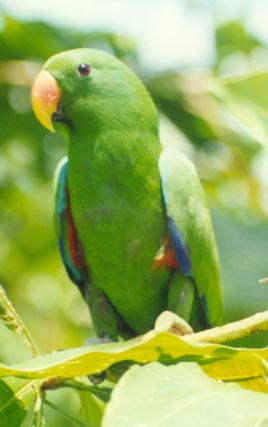Eclectus - Parrot
Grand Eclectus Scientific Name: Eclectus roratus roratus
Sat, 12th July, 2025 - 4:07 am GMT
Sponsor Ads:

Alternative Name
Grand Eclectus Scientific Name: Eclectus roratus roratusBasic Info
The Eclectus Parrot grows to about 35 centimeters in length with a 240-millimeter wing span. Their lovely, glossy feathers have a hair-like texture, and the species is quite obviously sexually dimorphic. Male Eclectus Parrots are predominantly green. The feathers of the head are lightly tinted with yellow, while the under-tail coverts are also yellow-green. The under-wing coverts and the sides of the body are red. The bend of a male Eclectus Parrot's wing is blue, and the primaries, though edged in green, are also blue. The tail feathers are tipped in olive yellow, and are green. Toward the edge of the tail, they darken in color to a blackish green and finally blackish blue at the very tip of the tail. The feathers themselves are tipped in yellow white. Male Eclectus Parrots have orange or yellow irises, and their bills are red with a lower tip. The lower mandible is blackish, and the feet are a dark shade of gray. Female Eclectus Parrots are red in color! Their iris is more yellowish than the male's, but the feet are gray and the bill is very dark gray or black. Female Eclectus Parrots have brownish-red backs and wings. The undersides of their breasts, the abdomens, the sides of the body, and the band across the back and nape of their necks are violet in color. Sometimes, the upper breast is also violet. The bend of a female Eclectus Parrot's wing is blue-violet in color, as is the edge. A darker shade of the same color covers the under-wing coverts. Female Eclectus Parrots have dark blue primary coverts and outer secondary feather webbing. Their tails' uppersides have yellowish-red edging, which is rather blurred; the underside of the tail is a more orange-red color and shows yellow edging.
Health
Some Eclectus Parrots are prone to stress induced feather plucking. Stress may be caused by a dominant mate or by changes in husbandry practices. Nutritional deficiencies, boredom, or cold temperatures may also cause feather plucking. Provide branches and leaves for your Eclectus to chew on and try to identify the cause of the feather plucking in order to immediately eliminate it. Eclectus Parrots have a longer digestive tract than any other parrot and they need more fresh veggies and fruits than most parrots. In general, Eclectus Parrots should be fed mixed fruits and vegetables along with softened soaked grains and seed. About 20 percent of the diet may be made up of a good basic seed mix although some people prefer to feed their parrots pellet diets. As special treats, dog biscuits, biscuit mix, or boiled egg are sometimes offered. Breeding Eclectus Parrots reach sexual maturity around two to three years of age. Sometimes, females will mature before their partners and dominate them, causing stress to the male. They become extremely aggressive during the breeding season and some have been known to attack handlers or other birds. To breed Eclectus Parrots in captivity you will need a nest box large enough for the parrots for mating. It should be designed like an L, which will prevent the female from entering the nest in such a manner that she breaks the eggs, by accident. Female Eclectus Parrots tend to spend lots of time in the nest box and like to chew it. They will usually lay around two eggs that incubate for about 28 days. Some breeders remove the first egg and replace it with an artificial egg until the second is laid in order to even the incubation of the two eggs to allow the hatchlings an equal chance for feeding. Usually the hen will sit on the eggs, though sometimes the male will sit as well. Some males will even help care for the chicks. Eclectus hatchlings are nearly featherless and acquire a down at two weeks of age before growing colored feathers at about a month of age. By 70 to 80 days, they will fledge and when you see them eating independently from their parents, they can be separated from the other birds. Hand-raised Eclectus Parrots make more docile pets than parent-raised birds.Habitat
N/ABehavior
Incredibly beautiful birds, Eclectus Parrots are so sexually dimorphic that many people assume that males and females are actually birds of different species when they see them together! The striking colors of these lovely Parrots only serve to compliment each other's differences. In the wild, Eclectus Parrots fly through the upper canopies of lowland forests in small groups or in pairs. They search for fruits, nuts, berries, nectar, seeds, blossoms and leaf buds. At night, Eclectus Parrots roost in large groups of up to 80 birds after a regular evening display flight. During flight, the Eclectus Parrot makes a repetitive screeching noise, but during feeding their calls are lower, and have been described as flute-like or wailing. They nest in holes in tall trees. In captivity, Eclectus Parrots do well in large or suspended aviaries having at least three and a half meters of length and one meter of width. They will need to be sheltered from the elements and are generally kept in pairs. Eclectus Parrots can be taught to mimic speech and hand-raised and co-parented parent raised chicks tend to make more docile pets than do entirely parent-raised chicks. These birds may be quite noisy although they are entertaining and rewarding pets.Origin
IndonesiaHistory
Although Eclectus Parrots were once native to Ambon, northeast Australia, New Guinea, Ceram, Buru, Indonesia, the Moluccan Islands, Haruku, and Saparua, they are now extinct on Ambon as well as Saparua and Haruku. In the 1980's, they were, however, one of the most commonly found birds in the Moluccan Islands and they are quite popular in aviculture. In the wild, they live in stands of tall trees in addition to forests at low altitudes.Common Foods
N/ASponsor Ads:
Play with boundaries, not within.
Eclectus - Parrot
Coded by: BGID® | ALL RIGHTS RESERVED Copyright © 2000-2025
Disclaimer | Privacy | Report Errors / Contact | Credits








 President of the United States of America - Real Estate mogul, Pageant owner and now one of the most controversial men in political history.
President of the United States of America - Real Estate mogul, Pageant owner and now one of the most controversial men in political history.  Global warming has been in and out as the "latest" hot topic for many years. It is, according to modern scientists, the result of man-made industrial pollutants, clearing forested areas, agriculture, etc. But now they are thinking it started way before the Industrial Revolution...
Global warming has been in and out as the "latest" hot topic for many years. It is, according to modern scientists, the result of man-made industrial pollutants, clearing forested areas, agriculture, etc. But now they are thinking it started way before the Industrial Revolution...  Politician, US Vice President and President of the USA - Joseph Robinette Biden Jr.
Politician, US Vice President and President of the USA - Joseph Robinette Biden Jr.  versus
versus  Russia: 'The Evil Empire'? Are they all that bad or is it just the USA trying to portray Russia as bad because they are a world power with land bigger and a society very different from the USA ideal?
Russia: 'The Evil Empire'? Are they all that bad or is it just the USA trying to portray Russia as bad because they are a world power with land bigger and a society very different from the USA ideal? 
 Corona virus
Corona virus 
 Users with wide screen monitors can benefit from more content on every page.
Users with wide screen monitors can benefit from more content on every page.